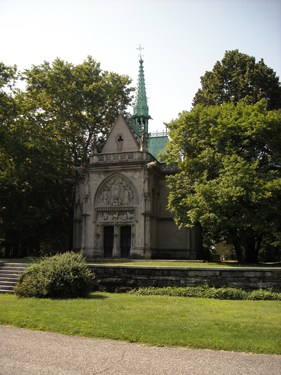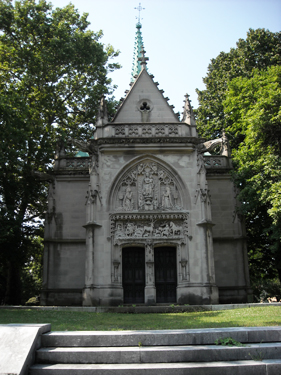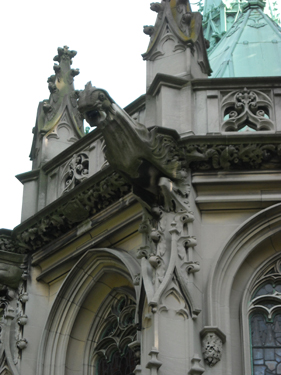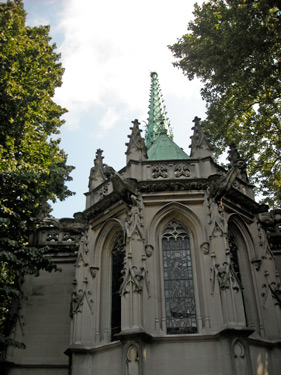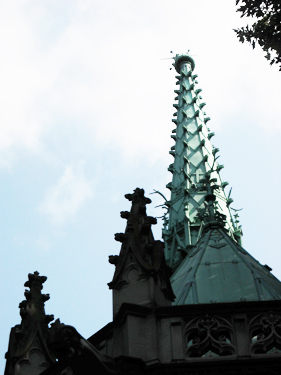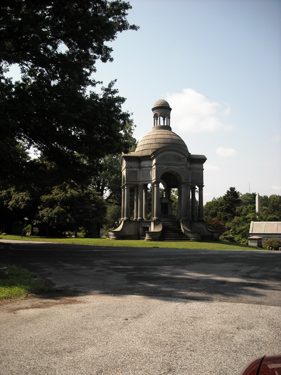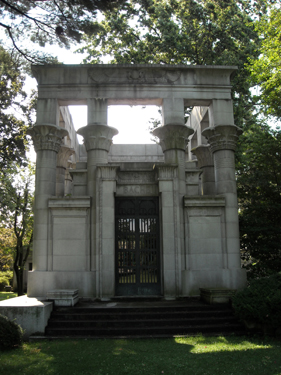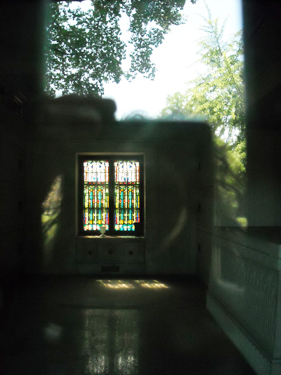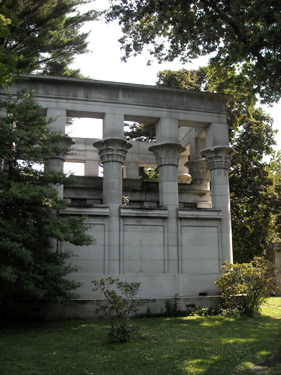Woodlawn Cemetery
Webster Avenue and 233 Street
or Jerome Avenue at Bainbridge Avenue
Belmont Chapel (Whitewood plot), 1913, Richard Howland Hunt; Goelet Mausoleum (Oak Hill plot), Russell Mausoleum (Highland plot), Osborn Mausoleum (Brookside plot), Taylor Mausoleum (Walnut plot), 1900-1902, McKim, Mead, and White; Straus Mausoleum (Mysotis plot), 1913, James Gamble Rogers
An 1852 health law forbidding further burials in growing Manhattan made it urgent to create cemetery space beyond city limits. Across the East River, packed necropolises, “cities of the dead,” began to appear. One of them, Calvary Cemetery in today’s Queens, buried 12,000 yearly in fields thick with headstones. (By the time it was closed, it held over three million.) Woodlawn Cemetery, opened in 1865, chose the alternative of making its 400 acres of hillside a “rural” burial ground, where graves and monuments would be absorbed into a carefully landscaped natural setting. Former Bronx River valley farmland was enriched with knolls, lawns, a pond, and exotic arboreal specimens, five of which appear today on the city’s register of its 100 greatest trees. To avoid formal ranks of graves and fenced enclosures, families were encouraged to build a focal monument or mausoleum, and peripheral carriageways were mapped to leave open spaces for the larger ones.
In addition to purifying the air, natural scenery was intended to relieve the gloom of death. Woodlawn offered the visitor the same kind of Romantic greensward to be found in the recently opened Central Park, along with memorial inscriptions and statuary to exercise his benevolent emotions. In fact, the cemetery attracted day-trippers in large numbers, becoming in effect the Bronx’s first public park, predecessor of Van Cortlandt, Pelham Bay, and four others in what is today New York’s most densely green borough.
But it was the steam locomotive, even more than a picturesque landscape, which assured Woodlawn’s early success. New York already had a garden cemetery, Brooklyn’s Greenwood, established in 1838. The rival was fashionable, but its location proved extremely inconvenient for Manhattanites, requiring cortèges to push through the streets of the downtown business district and—in the years before the Brooklyn Bridge—cross the river on boisterous commuter ferries. The New York and Harlem Railroad, on the other hand, ran from midtown directly to the front gate of Woodlawn. It awaited only the rites of Admiral David Glasgow Farragut in 1870, during which President Grant and other mourners were carried with the coffin by special train, to make the new practice of railroad funerals acceptable.
As a result of its direct Manhattan connection, Woodlawn became the final home of a remarkable urban population, both respectable and raffish. Along with the expected generals, mayors, financiers, and dry-goods magnates, the cemetery has gathered in journalists (like Finlay Peter Dunne, “Mr. Dooley”), executed criminals (like Ruth Snyder), vaudevillians (like Smith and Dale), restaurateurs (like Louis Sherry), and whole contingents of cartoonists (Nast, Held,...) suffragists (Stanton, Catt,...), and jazz musicians (Ellington, Hampton,...). The memorials in this Bronx graveyard make up a pantheon considerably more intriguing than the borough’s staid Hall of Fame.
But over time, the ideal of an Arcadian landscape has suffered. Like the once-suburban Bronx outside its gates, Woodlawn has been overbuilt: it now has tracts of simple headstones near the fences, streets lined with rows of small tombs and monuments, elite mega mausoleums along the main drive and on the hill tops, and even “apartment houses,” a growing number of communal vaults. Despite its beautiful lawns and trees, the cemetery has taken on the appearance of a small city that has somehow assembled its buildings from all corners of history.
Eclectic profusion is most extreme in the mausoleums of the Gilded Age. Beginning in the 1880’s, New York’s mercantile and financial plutocracy experienced something like a collective mania for building “historical” residences, which spilled over from the pocket palaces and castles of upper Fifth Avenue and the sprawling mansions of Newport onto the gravesites of the Bronx. Sophisticated, often Europe-trained American architects were hired to build tombs which accurately imitated the temples or vaults their patrons had learned to admire on Continental tours. The result is that Woodlawn today is a veritable museum of architecture.
One exhibit, just inside the Jerome Avenue gate (and across the road from an Egyptian temple), is the dual tomb commissioned by Alva Belmont on the death of her husband, and finished in 1913 under the supervision of Richard H. Hunt, successor to the firm of his father, society architect Richard Morris Hunt. The elder Hunt had built several houses for Alva, whose, sometimes imperious, involvement in the design process amounted to collaboration. (An enthusiastic amateur, she was the first woman admitted to the American Institute of Architects.) For their residences, Alva and many of her society peers favored Hunt’s “chateauesque” style, based on French royal castles of the Loire. For Woodlawn, she ordered an exact replica of the Chateau of Amboise’s Chapel of Saint Hubert.
The fifteenth-century original, perched high on a castle wall overlooking the river valley, has drawn tourists since its restoration in the mid-nineteenth-century. But cemetery visitors, who can walk completely around the Belmont tomb, get a much better view of its sharp geometry and vigorous carved detail. What they see is a miniature Gothic church (42.5 by 34 feet) in the form of a Latin cross, with a semicircular apse at one end, and at the other a porch bearing a sculpted stone lintel and tympanum. The profile of the grey limestone chapel is, in the “Flamboyant” manner, wonderfully spiky. A thin pointed spire (or flèche) stands at the crossing of the steeply-pitched roofs, and finials sprout at each corner of the parapet, with long-necked gargoyles stretching out horizontally below.
On the lintel, a scene in freestanding sculpture depicts the conversion of Hubert, out hunting on Good Friday when he encounters a miraculous stag with a crucifix between its antlers. The awe-struck huntsman is on his knees, attended by a patient horse. Baying dogs, two saints, and several angels observe the scene from among the carefully individuated forest trees. In the tympanum above, larger-than-life figures of Charles VIII and his queen kneel in profile on either side of the standing Virgin and child, while more angels entangle themselves in the tracery and support the heraldic arms of the Belmonts, which Hunt has discreetly substituted for those of the royal couple.
In using a church model, Mrs. Belmont’s mausoleum is exceptional. Among more than 1,300 aboveground tombs at Woodlawn, the great majority comes equipped with columns, pediments, and other attributes of classicism, the favorite funerary style of the wealthy.
American millionaires were energetic individualists, but they seem to have been timidly conventional in the face of death (or their architects). Jay Gould and Collis P. Huntington are interred in fairly indistinguishable Ionic temples; William Ziegler and Joseph Paterno each rest in their own personal reproduction of the Thesion at Athens. Still, it’s worthwhile to sift through redundant Attic tombs in search of the work of the firm of McKim, Mead, and White. The classical, in its many versions, was their “house style.” Beyond archaeological knowledge, they had the confidence to experiment with the design code.
Between 1900 and 1902, the firm completed four tombs that seem like a set of architectural variations on classical themes. Two, for the Goelets and Russells, are “Greek.” They begin with stark geometrical volumes—a cube, an octagon—and develop their outlines with open porches and closed extensions. Only above the cornice is there an outbreak of ornament: leaf acroteria, a stepped pyramidal roof (on Goelet), a three-branched bronze support for a tripod at Russell’s peak. The “Roman” pair, Osborn and Taylor, are compact and essentially cylindrical. The first is a chaste circular temple with a conical roof, like the so-called “Temple of Vesta” in Rome. Corinthian pilasters and a banded masonry shell replace the open peristyle of the original. In contrast, the Taylor mausoleum’s tall, attached columns and dramatic knife-edge cornice, zigzagging in counterpoint to the swelling shallow dome, are full-blown expressions of the Imperial manner (which was going to dominate MMW’s public buildings).
What’s missing in these and most of Woodlawn’s historical re-creations is some felt connection between the architecture and the life it commemorates. To find a building whose reference to the past imaginatively expands into the present and personal, we can turn to the memorial John Gamble Rogers has created for the Straus family, owners of Macy’s department store and New York political figures. On three sides of a flagstone courtyard planted with trees stand identical, strangely characterless tombs. These are single-story, blank rectangular blocks, facing the yard with plain walls of coarse-grained grey-brown ashlar, each with a central door. Their only ornaments are metalwork grilles, in different leaf forms, over the portals. On the yard’s fourth side, between two metal fences, is a low box of the same stone, serving as pedestal for an enigmatic object: the bluntly-carved, modernistic representation of an ancient oared galley with a hooded deck.
The box is inscribed with a passage from the Song of Songs--“Many waters cannot quench our love—neither can the floods drown it”—and the names of Isidor and Ida Straus, the parents, identifying it as a double sarcophagus. The Biblical verse recalls the well-known sea drama of the couple’s death in the 1912 Titanic disaster. Isidor Straus refused to board a lifeboat until all women and children had been saved; his wife would not leave his side. The sarcophagus holds only one body, Ida’s never having been recovered.
The stone ship seems to refer to this same event. But its full significance has to wait for our recognition that Gamble’s primitive geometric tombs are a loose version of an Egyptian mastaba complex, such as those found at Gizeh. (The barest iconographic hint is offered: classic lotus-flower decorations on the courtyard fence.) Once the ancient context is established, we can see that the sculpture imitates the model boats found in Egyptian tombs. These were images of the funeral barges that carried bodies across the Nile, and also of the solar boat used by Ra to bring dead souls to the underworld. The memory of the Titanic yields to the image of this other ship transporting the faithful couple to immortality.
David Bady
